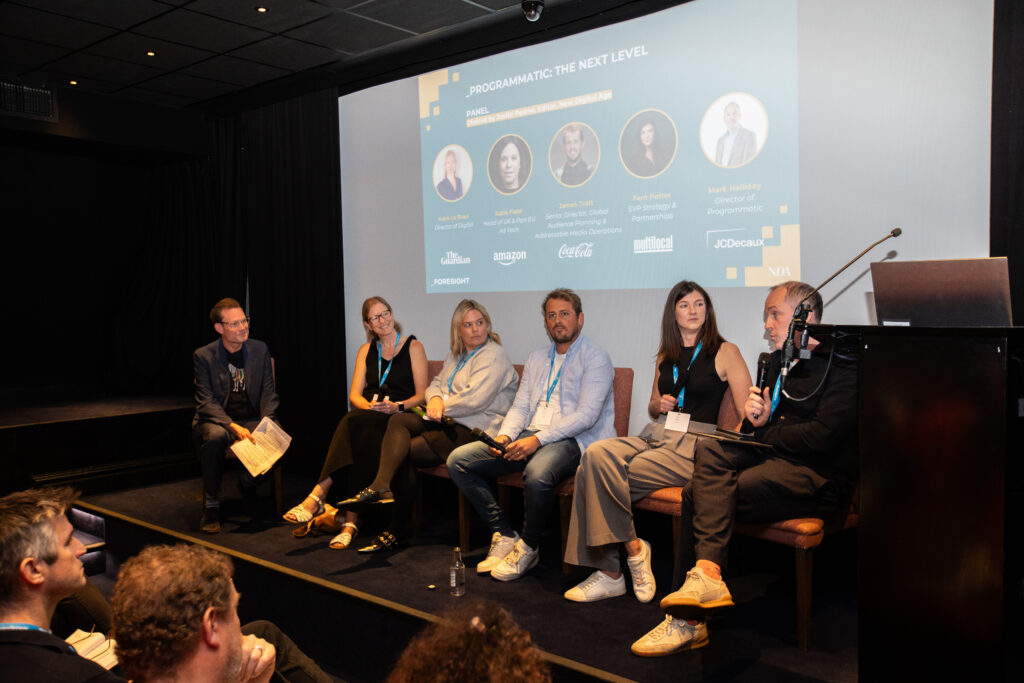Last year, we asked our Programmatic panel at our Foresight conference how mature they thought the sector was, by likening it to a child. We got various responses, but the consensus seemed to be ‘hormonal’. Posing that question 12 months on and it would seem there’s been a bit of growing up going on.
“It’s got a bit more focus, more confident,” suggests Katie Field, Head of UK & Pan EU Ad Tech at Amazon. James Trott,Senior Director, Global Audience Planning & Addressable Media Operations at Coca-Cola, reckons it’s entering its university years, to get a bit of research nous under its belt and “prove ROI like it never has before”.
Mark Halliday, Director of Programmatic at JCDecaux UK took a different view, speaking to the wide scope of programmatic today by saying “it’s a family of children, different channels with different levels of maturity.” He singles retail media out for being the new kid on the block who needs to learn the rules, and how to play nicely with the other kids.
Of course, when you learn to play by the rules, it helps if the rules don’t keep changing on you. Cookie deprecation, something the industry thought was finally done and dusted – isn’t. It looks like they’re here to stay.
Katie Le Ruez, Director of Digital at The Guardian, notes “there are lots of things we can’t control – we can try to influence them but instead we focus on what is in our control. That is developing our first party data, the structure that underlies [it] and thinking about consent.”
Whether cookies stay or if they go, the industry is recognising that they were limited anyway so if anything, deprecation was the spur needed to go find better solutions. “We’ve been thinking for years now about more durable solutions to close the gap for advertisers to allow them to talk to their customers across channels,” Field reveals.
Trott agrees, “we found some better solutions in terms of targeting and measurement that we’re going to continue to develop. First party doesn’t come quite as naturally to us as other digitally native businesses but we see a lot of value and we’re doing our best.
“A lot of testing has taken place to ensure a cookie-free environment where publishers can still monetise through programmatic,” says Fern Potter, SVP of Strategy and Partnerships at Multilocal. “It’s vital to consider the user experience and value exchange, while also ensuring that the technology enables effective programmatic advertising.”
JCDecaux’s Halliday is more bullish. “Cookies have been dying a slow death for a while and the industry should just pull the plug on them.” He feels that they’re even holding the industry back, citing JCDecaux’s use of geotargeting as an alternative. It’s not just limited to out of home. Open source data sets including postcodes, telcoms data, and more can also be used for connected TV, programmatic audio etc. to create seamless multi-channel campaigns. This shift away from rudimentary planning to strategic, data-driven agile activation and optimisation will drive the growth of new programmatic channels.”
Trott adds that his current obsession is sales data, trying to understand the share of voice or market is at a postcode level. “Have I got headroom for growth? Then you can deploy media into those postcodes and look at it a month later to measure. It’s a beautifully simple way of doing things.”
Undeniably, the proliferation of channels is both an opportunity and a challenge for the programmatic ecosystem. “It’s about closing the measurement loop. We need to make sure, cookies or no cookies, that there is a way to measure the value, test and learn, as well as grow and replicate those audiences,” Field suggests.
Le Ruez agrees that measurement is a hot topic, particularly when it comes to knowing audiences. “We’re thinking about pre-campaign data collection, activating against people we know have shown interest or intent. But we need consent in the first place. The question of transparency has evolved. It’s incredibly hard to get the money where advertisers and media owners want to go so the question about transparency is bigger than ever.”
“Curation enhances transparency between the buy and sell sides. By curating a PMP on a one-to-many basis, you retain full control and transparency while reaching the right audiences at scale. Once live, curated PMPs can be optimised to meet specific campaign KPIs, ultimately driving better results for all parties involved,” says Potter.
Trott feels curation is going to be a big part of programmatic’s future but that there are three, key considerations. “One the open web is really important, two that it has risk and three – how do we solve that?” His answer is first to clean up the supply chain – replicating a clear demand side strategy on the supply side and finding who is best in class. And secondly, having the best possible understanding of the media you’re accessing.
Naturally, it’s not possible to leave a panel without poking the great, artificial elephant in the room. Field agrees that there is a great deal of responsibility in using AI in programmatic. “We have a big job to take friction away from our advertisers and give them a way to speak easily to customers. AI is fundamental to that. Customers and partners are open to understanding more about it. It’s exciting but it’s not the tools themselves, but what they enable.”
Le Ruez has high hopes for AI. “We want people to stay on our site and have a great experience but if you’re seeing terrible creative it doesn’t create a brilliant environment. Improvements to creative with generative AI would be phenomenal.” She also points to brand safety as a key element that AI can play a role in securing.
Has programmatic grown up? Perhaps – a little at least. But, with any maturity, getting older and wiser brings with it a whole new set of complications. As programmatic steps out into the wider world, more channels, broader audiences, there will be bigger problems to solve. But, with a sense of optimism in the room, (whatever cookies feel like doing next week) programmatic is definitely on the right track.
* A full downloadable report featuring all the insight of our recent Foresight conference will be published soon on NDA.












